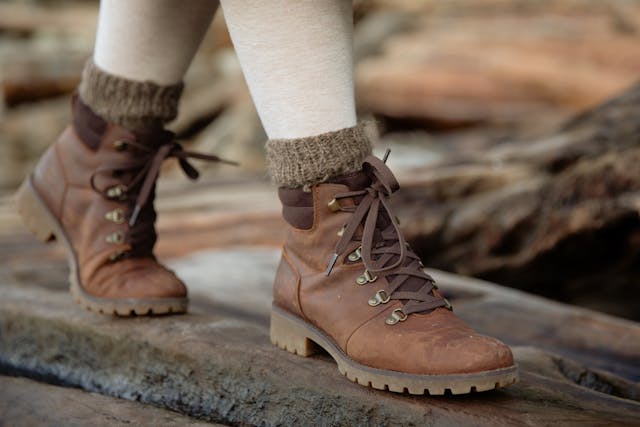When to Wear Work Boots: 7 Key Times You Must Know!
Work boots are more than just footwear. They provide protection, stability, and comfort in different environments. Many jobs require them for safety reasons, while others benefit from their durability. Knowing when to wear work boots ensures you stay safe and avoid injuries.
In this guide, we will discuss the key situations where work boots are necessary. Whether you work on a construction site, in an industrial setting, or enjoy outdoor activities, having the right boots makes a difference.
Why Work Boots Matter in Tough Environments
Work boots are designed to withstand tough conditions. They protect your feet from injuries caused by falling objects, sharp materials, or slippery surfaces. In many industries, wearing proper footwear is not just a choice—it is a requirement.
The right pair of work boots provide support and help prevent foot fatigue. Long hours on hard surfaces can lead to discomfort and pain. With proper cushioning and arch support, work boots keep you comfortable throughout the day.
Let’s explore some of the most common places where work boots are a must-have.
7 Best Times to Wear Work Boots for Maximum Safety!

1. Construction Sites: A Must-Have for Protection
Construction sites are one of the most dangerous workplaces. Heavy materials, sharp tools, and uneven surfaces increase the risk of injury. Wearing work boots protects your feet from falling objects, nails, and debris.
Steel-toe boots are especially useful in these settings. They shield your toes from heavy impacts. Some boots also have puncture-resistant soles to prevent injuries from sharp objects on the ground.
Slip-resistant soles help maintain balance on wet or unstable surfaces. If you work in construction, investing in a good pair of work boots is essential for safety and comfort.
2. Industrial Workplaces: Safety First!
Factories, warehouses, and manufacturing plants often have strict safety requirements. Workers deal with heavy machinery, chemicals, and electrical hazards. Wearing proper work boots reduces the risk of injuries.
Electrical hazard (EH) boots prevent electric shocks. These are important for workers dealing with wiring or electrical equipment. Chemical-resistant boots protect feet from harmful substances that can cause burns or skin damage.
In industrial environments, standing for long hours is common. Boots with good arch support and cushioned soles help reduce fatigue and discomfort.
3. Hiking & Rough Terrains: Extra Grip & Support
Work boots are not just for job sites. Outdoor enthusiasts, hikers, and adventurers can also benefit from their durability and support. When walking on rocky or muddy trails, regular shoes might not provide enough grip.
Work boots with deep treads improve traction and stability. Ankle support reduces the risk of sprains or injuries. Waterproof work boots keep feet dry in wet conditions, making them perfect for hiking or exploring rough terrains.
4. Extreme Weather: Keep Your Feet Protected
Cold or hot weather can be harsh on your feet. Wearing the right boots ensures protection and comfort. In winter, insulated work boots keep feet warm and prevent frostbite. Waterproof boots are useful in snow and rain, preventing moisture from seeping in.
In hot conditions, breathable work boots with moisture-wicking lining help prevent sweating and discomfort. Boots with heat-resistant soles protect feet from extreme heat, especially for workers in outdoor jobs or near hot surfaces.
5. DIY Projects & Home Renovations
Home improvement projects involve tools, heavy materials, and sharp objects. Whether working on flooring, building furniture, or landscaping, safety is important. Work boots protect feet from accidents like dropped tools or falling debris.
Slip-resistant boots prevent accidents on wet or uneven surfaces. If you enjoy DIY projects or home renovations, having a sturdy pair of work boots is a smart choice.
6. Farming & Landscaping Work
Farmers and landscapers spend hours on their feet. Working with soil, water, and machinery requires durable and comfortable footwear. Work boots offer protection from sharp tools, rough terrain, and weather conditions. We inlisted best work boots for farmers you must know about that.
Waterproof boots keep feet dry when working in wet fields. Steel-toe or reinforced boots protect against heavy objects like equipment and livestock. Breathable materials help maintain comfort in hot weather.
7. Emergency & Rescue Work
First responders, firefighters, and rescue workers face unpredictable and dangerous situations. Proper footwear is essential for protection and mobility. Work boots with slip-resistant soles help in wet or unstable conditions. Fire-resistant boots protect against extreme heat, while reinforced boots offer impact protection.
In emergency situations, comfort and durability matter. Rescue workers often work long hours in tough environments, making high-quality work boots a crucial part of their gear.
Conclusion
Work boots are essential for many jobs and activities. They provide safety, support, and durability in different environments. Whether working on a construction site, in a factory, or exploring the outdoors, the right boots make a difference.
Choosing work boots based on your specific needs ensures comfort and protection. Investing in quality footwear is a step towards better safety and performance in everyday tasks.


